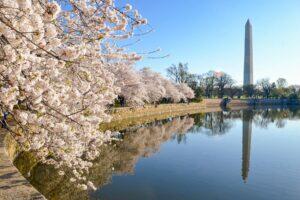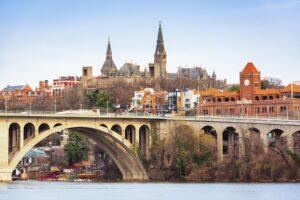Parks
Washington is more than marble-and-limestone buildings. The city is blessed with numerous parks and outdoor attractions that provide a break from the museums and government facilities. Rock Creek Park extends through much of the city, with entrances to the park near many hotels. Other outdoor spaces, such as the National Mall, Potomac Park, and Constitution Gardens, offer a chance to see nature, combined with the beauty of nearby waterways and the majesty of the city's beloved monuments.
C&O Canal. George Washington was one of the first to advance the idea of a canal linking the Potomac with the Ohio River across the Appalachians. Work started on the Chesapeake & Ohio Canal in 1828, and, when it opened in 1850, its 74 locks linked Georgetown with Cumberland, Maryland, 185 miles to the northwest (still short of its intended destination). Lumber, coal, iron, wheat, and flour moved up and down the canal, but it was never as successful as its planners had hoped due to damaging floods and competition from the Baltimore & Ohio Railroad. Today, the canal is part of the National Park System; walkers and cyclists follow the towpath once used by mules, while canoeists paddle the canal's calm waters. Ongoing construction to repair and restore locks can often result in towpath closures. The Georgetown Visitor Center is also closed until further notice. 1057 Thomas Jefferson St. NW, Georgetown, Washington, District of Columbia, 20007. 301/767–3714; www.nps.gov/choh. The park is free to visit except the Great Falls Tavern area in Potomac, MD. Visit the website for updated fee information.
East Potomac Park (). This 328-acre finger of land extends south of the Jefferson Memorial from the Tidal Basin, between the Washington Channel and the new Southwest Waterfront redevelopment neighborhood to the east and the Potomac River to the west. Locals consider the park a retreat with its playgrounds, picnic tables, tennis courts, swimming pools, driving range, one 18-hole and two 9-hole golf courses, and miniature golf. There's also a scenic riverfront trail that winds around the park's perimeter. Double-blossoming Japanese cherry trees line Ohio Drive and bloom about two weeks after the single-blossoming variety that attracts throngs to the Tidal Basin each spring. Ohio Dr. SW, The Mall, Washington, District of Columbia, 20024. 202/426–6841; www.npca.org/parks.
Fort Reno Park. At 429 feet above sea level, the highest point in Washington has been used in different eras as a Civil War fort, the site of telegraph and radio towers, and a reservoir. In 1864, Abraham Lincoln watched nearby as outnumbered Union troops defended the capital from a formidable Confederate advance led by General Early, in the only battle to take place in the capital. Today, the park is enjoyed by soccer players, dog-park regulars, and picnickers. Most of the Civil War–era earthworks are gone, and two curious faux-medieval towers, built in 1929, mark the reservoir site, which is not accessible to the public. Nonetheless, the park has an appealing city view and plenty of room to run around. A popular, free outdoor concert series takes place every summer featuring many of the area's most esteemed indie-rock acts, from Fugazi to Dismemberment Plan to Priests. Chesapeake St. NW at Nebraska Ave. NW, Upper Northwest, Washington, District of Columbia, 20016. 202/895–6070; 202/521–1493; www.fortreno.com.
Glover-Archbold Park. Groves of beeches, elms, and oaks flourish at this 183-acre park, part of the Rock Creek system, which begins just west of Georgetown and ends, 3½ miles later, near Van Ness Street. Along the way you'll experience a stream valley with ancient trees and possible bird sightings. And chances are you'll have the trail mostly to yourself. Wisconsin Ave. at Van Ness St. NW, Upper Northwest, Washington, District of Columbia, 20037. www.nps.gov/pohe/index.htm.
Rock Creek Park. The 1,800 acres surrounding Rock Creek have provided a cool oasis for visitors and D.C. residents ever since Congress set them aside for recreational use in 1890. The bubbling, rocky stream draws nature lovers to the miles of paved walkways. Bicycle routes, jogging and hiking paths, and equestrian trails wind through the groves of dogwoods, beeches, oaks, and cedars, and 30 picnic areas are scattered about. An asphalt bike path running through the park has a few challenging hills but is mostly flat, and it's possible to bike several miles without having to stop for cars (the roadway is closed entirely to cars on weekends). The most popular run in Rock Creek Park is along a trail that follows the creek from Georgetown to the National Zoo, about 4 miles round-trip. Rangers at the Nature Center and Planetarium introduce visitors to the park and keep track of daily events; guided nature walks leave from the center on weekends at 2. The park is open only during daylight hours. 5200 Glover Rd. NW, Nature Center and Planetarium, Upper Northwest, Washington, District of Columbia, 20015. 202/895–6070; www.nps.gov/rocr. Nature Center: Wed.–Sun. 9–5; Planetarium shows: Wed. at 2, weekends at 1 and 4.
Meridian Hill Park. Landscape architect Horace Peaslee created Meridian Hill Park, a noncontiguous section of Rock Creek Park, after a 1917 study of the parks of Europe. As a result, it contains elements of gardens in France, Italy, and Switzerland. John Quincy Adams lived in a mansion here after his presidency, and the park later served as an encampment for Union soldiers during the Civil War. All 50 states are represented by a state tree or flower. Meridian Hill is unofficially known as Malcolm X Park in honor of the civil rights leader. Weekends bring a mix of pickup soccer games, yoga, joggers running the stairs, and a weekly (weather permitting) drum circle. A statue of Joan of Arc poised for battle on horseback stands above the terrace, and a statue of Dante is on a pedestal below. Cell-phone tours illuminate the history of the landmarks inside the park. Meridian Hill Park, 16th St. NW and W St. NW, Adams Morgan, Washington, District of Columbia, 20009. www.nps.gov/mehi.
Tidal Basin. The Tidal Basin, a partially man-made reservoir between the Potomac and the Washington Channel, is part of West Potomac Park, adjacent to the Mall. It's the setting for memorials to Thomas Jefferson, Franklin Delano Roosevelt, Martin Luther King Jr., and George Mason. Two gargoyles on the sides of the Inlet Bridge can be seen as you walk along the sidewalk that hugs the basin. The inside walls of the bridge also feature two other sculptures: bronze, human-headed fish that once spouted water from their mouths. Sculptor Constantin Sephralis, who also worked on the National Cathedral, made them in honor of John Fish, the chief of the park, who was retiring at the time. Once you cross the bridge, continue along the Tidal Basin to the right. This route is especially scenic when the famous cherry trees are in bloom. The trees, a gift from the Japanese during the administration of William Howard Taft, are perhaps the Tidal Basin's most iconic feature beyond the memorials.
Bordered by Independence and Maine Aves., The Mall, Washington, District of Columbia, 20024.
West Potomac Park. Between the Potomac and the Tidal Basin, this park is known for its flowering cherry trees, which bloom for two weeks in late March or early April, and for a slew of memorials, including those honoring Abraham Lincoln, Martin Luther King Jr., Franklin Delano Roosevelt, Thomas Jefferson, and George Mason, as well as the World War II, Korean War, and Vietnam War Veterans memorials. It's a nice place to play ball, picnic, or just relax while admiring the water views. Bounded by Constitution Ave., 17th St., and Independence Ave., The Mall, Washington, District of Columbia, 20024. www.npca.org.
WWI Memorial/Pershing Park. In late 2014, Congress redesignated this quiet, sunken garden, to honor General John J. "Black Jack" Pershing, the first—a century ago—to hold the title General of the Armies. An official unit of the National Park System, the memorial currently includes engravings on the stone walls recounting pivotal campaigns from World War I, when Pershing commanded the American expeditionary force and conducted other military exploits. Steps and small tables surround a fountain and duck pond, making for a pleasant midday respite. A $46 million renovation of the memorial is currently underway and is expected to be completed in 2021. 15th St. and Pennsylvania Ave., Downtown, Washington, District of Columbia, 20004.






